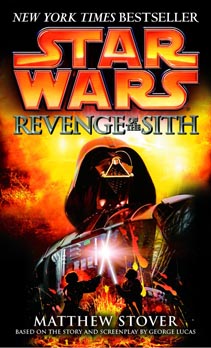Among the films, the original trilogy is clearly better than the prequel trilogy, but among the novelizations, the opposite is true. It’s not because of anything Alan Dean Foster, Donald Glut and James Kahn did wrong; rather, it’s because the nature of novelizations changed. In the ’70s and ’80s, they allowed moviegoers to relive the movie, but in the late ’90s and 2000s – when you could watch the movie at home soon after the theatrical run – people wanted more out of novelizations than a straight retelling.
George Lucas worked with Terry Brooks to add extra scenes to “Episode I,” and R.A. Salvatore helped make sense of the Anakin-Padme romance in “Episode II.” For the “Episode III: Revenge of the Sith” novelization (2005), Lucas let Matthew Stover run wild. Even though I think this is the most flawed “Star Wars” film, it’s far and away the best novelization.
Admittedly, it’s heavy-handed when Stover states “This is how it feels to be Anakin Skywalker/Obi-Wan Kenobi/etc.,” but I forgive that because he is indeed great at inviting the reader into characters’ mind spaces. Rather than giving blow-by-blow details of action scenes, he focuses on one character’s thoughts as a scene plays out. Take the Yoda-Sidious lightsaber duel, for instance: Stover writes about the broad momentum of the fight and what it means for the nature of the Force. In a story with so many lightsaber fights, the variety is welcome; earlier in the book, we get insight into Mace Windu’s fighting style, Vaapad.
The fact that it’s wonderfully written is the main reason to read “Revenge of the Sith,” but it’s also interesting to look back at Stover’s book in light of things that have happened to the “Star Wars” franchise in 11 short years:
Disney’s announcement that the movie novelizations carry over to the new canon puts “Revenge of the Sith” in an incredibly odd position, because the book is loaded with EU details, particularly from the “Republic” comics and the novels “Shatterpoint,” “The Cestus Deception” and “Labyrinth of Evil.” Since those stories are NOT part of the Disney canon, it creates a bizarre situation where Stover’s references to those books are accurate, even though the events of those books didn’t happen.
For example, the Jedi’s search for the Sith Lord DID take them to 500 Republica and The Works (because Stover writes as much in “Sith”), yet “Labyrinth of Evil” — the story about the Jedi’s search for the Sith Lord taking them to 500 Republica and The Works – DIDN’T happen (even though Stover was naturally thinking about the events of that book). But I guess that’s what Disney wants: The new novel “Thrawn” shows that Disney is interested in telling similar but slightly different versions of EU stories, despite its earlier claim that it wanted to create a new timeline in order to have a fresh slate. It probably doesn’t bother brand-new fans, but for old-school fans, reading similar-but-slightly-different stories isn’t all that appealing.

Another oddity about the “Sith” novelization is that some details were later contradicted by the 2008-14 “Clone Wars” TV series. This novel states or implies that Obi-Wan and Anakin are fighting the magna guards for the first time (page 121 of the paperback), that Darth Maul was killed by Obi-Wan on Naboo (161), that no one except C-3PO calls Anakin “master” (167), that Obi-Wan’s meeting with Grievous on the Invisible Hand was his first (255) and that Qui-Gon offers to teach Yoda to become one with the Force for the first time in this story (441).
In light of the TV series, all of those details are apocryphal. Obi-Wan and Anakin fight magna guards in the “Clone Wars” movie, and in the series proper, Darth Maul returns to harass our heroes, Ahsoka calls Anakin “master” many times (although she says “Skyguy” sometimes too) and Obi-Wan fights Grievous several times. In “The Lost Missions,” Qui-Gon offers to teach Yoda how to become one with the Force on Dagobah.
The novelization does not have Anakin say a line indicating that this is his first meeting with Grievous. The movie itself does, though, which is why Anakin could never meet the general in “The Clone Wars.” Contradicting the movie would’ve been a big deal; contradicting the novelization, not so much. So Obi-Wan was therefore free to face Grievous in “The Clone Wars.”
In the most blatant example of how Stover had free reign to be creative, he puts Shaak Ti in the Jedi Temple as Anakin heads off to confront Palpatine and Mace Windu. In a cut scene from the movie, Shaak Ti is killed by Grievous before this point, so Stover obviously knew the scene was cut before he wrote the book. Including Shaak Ti in the Temple is an odd choice, though, as the author doesn’t have her confront Anakin upon his return when he is slaughtering younglings, and he doesn’t tell us how she escapes from the Temple. Stover makes Bail Organa’s – and later, Obi-Wan’s and Yoda’s — escape from the clones and Emperor’s guards rather harrowing, so Shaak Ti – who later pops up in “The Force Unleashed” as a rare Jedi who survived Order 66 – perhaps should’ve gotten such a scene as well.
Stover particularly does a great job letting us understand Anakin’s thought process. Obi-Wan’s former Padawan is clearly a troubled person, and his actions are utterly inexcusable, but a reader does feel his fear that Padme will die in childbirth, and his desire to use Palpatine’s alleged knowledge to save her. In the movie, Anakin’s arc doesn’t work quite so well.
The only time Stover seems to miss the mark is on page 422, when Anakin pitches to Padme the concept that Palpatine’s evil will cause the galaxy to unite against him, and the end result will be a peaceful galaxy. This conflicts with Anakin’s belief in power, expressed in “Attack of the Clones” when he says the galaxy needs an authoritarian ruler, and it also shows a level of convoluted political strategy not typical of Anakin (who regularly says he loathes politics).
As meaty as Stover’s book is, he doesn’t try to do too much, which is why – despite the handful of continuity glitches it created – “The Clone Wars” still had a lot of fertile ground to explore. For instance, Stover does nothing with the background of Order 66.
One disappointing thing about both Stover’s book and the wider Clone Wars era is that Palpatine’s speciesism is not explored in detail. Of course, the real-world reason why there were few Imperial aliens in “A New Hope” is the budget for making creatures (there weren’t many Rebel aliens either), but as the saga went forward, the human-centric nature of the Empire was explained by Palpatine’s speciesism. But in Stover’s book, we don’t find out the fates of his nonhuman advisors, Mas Amedda and Sly Moore. It seems Palpatine chooses to not execute Amedda and Moore as he did the Separatist leadership, which raises the question of why he spared them.
On this re-read, I was also interested to see if Stover delineated the fact that Sidious kills Padme through the Force more clearly than the film does. Surprisingly, it’s much LESS clear than the film, as it seems like Vader’s resurrection happens a few days after Padme’s death. The film, on the other hand, syncs the end of Padme’s heartbeat with the beginning of Vader’s as a clue to what Sidious is doing. This combines with the information that Padme died despite being in perfect health; the clincher is Sidious telling Vader about Padme’s death.
Sidious’ line about Padme’s death is in the book, too, but Stover doesn’t make the connection clear, even though it would’ve been fascinating at this point to read about how much Sidious really does know about influencing life and death. (He brings Vader back to life only by sucking the life from Padme, but by the end of “Return of the Jedi,” he transfers his own life essence into a clone, leading to “Dark Empire.” Of course, the Emperor’s resurrection is now non-canon, but Stover didn’t know that when writing “Sith.”)
There are two possibilities for why Stover skims over this key story point: Either Lucas told Stover to de-emphasize Sidious’ Force-murder of Padme, or Stover himself didn’t make the connection. I think the latter is the case, but to be fair, a lot of fans didn’t either, until Joseph Tavano’s RetroZap article a few years back. (And to be fair to those fans who missed the point – me included — “Sith” explicitly presents us with the information that Padme “died of a broken heart.” In a prequel trilogy where most information is bluntly stated to the audience, it was hard to recognize that Lucas was bowing out on a subtle note where we had to dig deeper. It could also be argued that Lucas didn’t effectively portray the sequence in the movie – that he simply failed as a storyteller on that point.)
Overall, though, Stover deserves credit for making “Revenge of the Sith” all his own – with not only additions, but also judicious cuts for the sake of pacing (the Kashyyyk sequence is absent). Although Stover stays completely true to the plot, he crafts a better tale out of this plot by being a great character writer.

